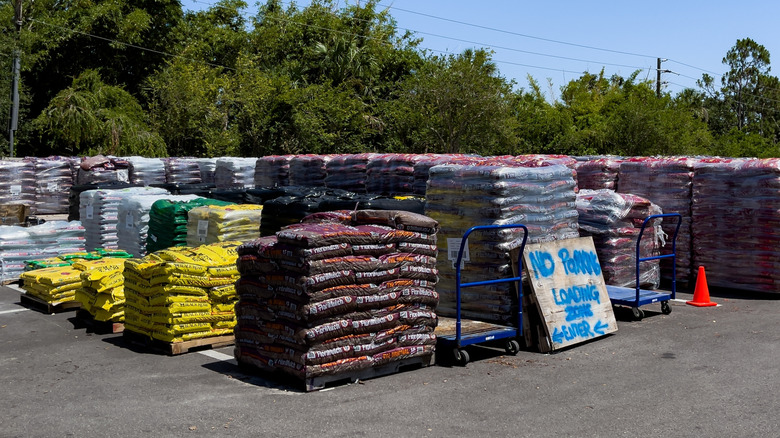The One Color Mulch That's Making Your Yard Look Outdated
We may receive a commission on purchases made from links.
There are two main reasons why people include mulch in their landscaping: for practical benefits (like weed and erosion prevention) and for aesthetics. Most mulch comes in black, brown, or red. If you're looking for a type of mulch that offers the most benefits, you may want to avoid using red.
Red mulch used to feel like a fresh addition to a yard, offering a unique contrast against lush greenery. For many homeowners, it added a necessary pop of color and a new-found sense of personalization, signaling that they were investing in the overall appeal of their outdoor spaces. But much like the mulch itself after too much exposure to sunlight, that appeal has faded. What once felt modern now reads as entirely too harsh and outdated.
Red mulch seems to be taking the hit in the new era of modern landscape, which favors natural textures and neutral tones around the garden. With landscaping trends leaning more into earthy color palettes, red mulch is increasingly being phased out in favor of more subtle options. A simple switch to a more neutral tone of mulch, whether it's a muted black, brown, or tan color, can make a world of difference in creating a clean and cohesive feel around your outdoor spaces. Discover why red mulch is outdated and how to choose the best mulch color to instantly enhance the curb appeal of your home.
Why red mulch is outdated and what to use instead
The main problem with red mulch is that it feels entirely artificial in just about every setting. Most native and eco-friendly mulch options, whether they're shredded hardwood, pine straw, or simple grass clippings, are able to blend into the natural landscape of your yard. They tend to incorporate muted brown shades that feel right at home among your outdoor spaces. Red mulch, on the other hand, draws attention to itself with its vibrant color. It disrupts the visual flow of your garden beds and can even compete with your flowering plants for attention within your yard. Additionally, dyed mulches tend to fade unevenly, which can leave your yard looking unprofessional.
Instead, brown mulch is arguably the most versatile option, as it is available in a number of materials and textures. It mimics the look of the healthy soil underneath and works across a wide range of landscaping designs. Brown mulch won't compete with your plants for attention, providing a grounded base for any garden bed. If you want a mulch with a more natural feel, shredded bark or pine mulch can offer both function and form. These materials naturally break down into the soil, improving its texture and nutrients.
There are plenty of ways make your mulch look brand new, even if you decide to stick with dyed mulches. Black pairs exceptionally well with industrial and modern home exteriors, especially those with metal outdoor accents and sleek hardscaping. Black mulch also tends to hold its color for longer than other options and provides that intentional feel for your garden beds.

